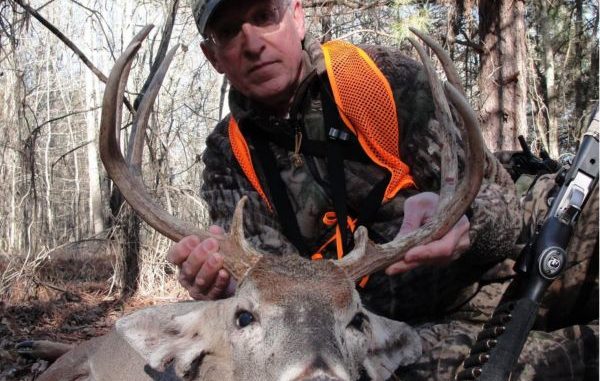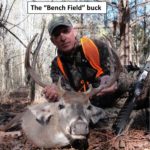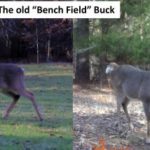
The natural evolution of a deer hunter
A couple of years ago one frosty clear morning in early January 2011, as the whitetail rut was rapidly drawing to a close, I still had not closed the deal on a particular 6 ½-year-old buck that had been on our hit list for the better part of two seasons.
He was a big, mature, dominant mainframe 8-point with an obvious attitude and swagger that came across clearly in the scores of trail-camera photos that we had of him. We named him the “Bench Field Big Eight.”
A detailed analysis of trail-camera photo data that season pointed to an area of roughly 100 acres that appeared to be the core area of his home range. I had last rotated trail-camera memory cards about six days earlier, and the data to that point indicated a narrow fairway about 200 yards wide that he seemed to frequent as he traversed back-and-forth across his core area.
The forecast wind conditions that morning were absolutely perfect for a box stand in the central part of the fairway at the junction of a woods road T, with a small secluded food plot in view to the left.
I climbed up into the stand before first light and settled in for my morning vigil. Nothing stirred until about 45 minutes after shooting light, when I began to hear the crunching sound of footsteps to my right rear.
Glancing over my shoulder, I noticed an extremely nice but immature heavy-beamed 6-point easing along through the timber toward the woods road spur to my right. I recognized him as a buck that had been previously seen in the area on trail-camera photos.
I watched him cross the road and disappear into the wood line.
Within moments I heard what sounded like another deer walking along the first buck’s back trail. I swiveled to the right and brought my field glasses up.
To my surprise, there was a second buck coming down the exact same trail, but this buck’s body and antlers were noticeably larger and more impressive than the first buck. Through my field glasses I instantly recognized him as the Bench Field Buck, and he was only seconds away from the edge of the woods road shooting lane.
I quickly dropped the field glasses and swung my .35 Whelen TC Encore into position as he passed from view behind a cedar tree at the edge of the road. Then, as the buck entered the narrow woods road, my thumb locked the hammer into firing position and the crosshairs of my scope settled on his shoulder.
I squeezed the trigger and at the thunderous shot the buck lunged from view into the wood line and crashed away through the brush.
After an easy trailing job of less than 100 yards, due to a heavy blood trail, I found the buck piled up at the foot of a large pine tree. It was indeed the Bench Field Buck, and his dominance was confirmed by a host of scabbed-over puncture wounds, ripped and torn ears, and patches of missing hair in several places.
To me, there is almost nothing more satisfying than to finally harvest an “old-as-the-hills” fully mature buck after a tough multi-month or multi-year quest.
Now, let’s rewind the tape back to a couple of weeks before that fateful morning and give you the rest of the story.
My son Jason had come up from his home in Louisiana to our farm in Mississippi to deer hunt for the weekend. Since we were both on the hunt for the Bench Field Buck but Jason’s hunting opportunities were much more limited than my own, I gave him first pick of the available stand locations.
He chose a great spot for his first afternoon that afforded him the ability to set up a video camera to record the hunt. He saw several young bucks and a number of does over the course of the afternoon, and then right at dusk — with shooting light almost gone — he noticed a large-bodied deer suddenly appear in the food plot that the stand overlooked.
A close look through his field glasses confirmed that it was the Bench Field Buck feeding about 90 yards away with a handful of does. He quickly activated the video camera, but his heart sank as he looked through the view finder and realized that he could barely make out the buck’s outline.
He had dearly wanted to get the buck on video if he had an opportunity to harvest him. He decided that, with another entire day left to hunt, he would wait until after dark and slip quietly out of the stand, and try for a repeat performance the following day. This particular stand is set up where you can easily slip in and out without arousing the notice of deer in the food plot.
The next day Jason decided to spend the entire afternoon in the stand, and just maybe his quarry would come back right at dark since he had not been spooked the previous evening.
My personal plan for that afternoon revolved around going somewhere that would be far enough away from Jason to not interfere with his hunt for the Bench Field Buck. I wound up settling on a real pretty spot in a hardwood bottom at least a half mile away from where Jason was sitting.
The only complication with my choice was that there was no stand or blind in that particular area. So, I had to find a spot where I could sit on the ground and still have reasonable visibility and concealment. My destination turned out to be the rotting carcass of a long ago blown-down white oak of enormous proportion on the edge of a hill overlooking the selected hardwood bottom.
I eased stealthily into the chosen area and sat down with my back resting against the horizontal tree trunk relic. Within just a minute or two, before I could even put my camo gloves on and get comfortably situated, I saw flickers of movement across the bottom about 100 yards away. Carefully easing my binoculars up, I was stunned to see the Bench Field Buck walking straight toward my location.
My binoculars remained riveted on him as he rapidly closed the distance, finally halting about 25 yards away at an active scrape. He slowly swung his head and rack from side to side as he surveyed the area, before pawing the scrape like a dog digging for a bone.
He then stepped over the scrape and freshened it by putting his hind legs together and peeing down his hocks.
Here I was on the ground close enough to hit with a rock the very buck I had been after for so long. Strangely enough though, there was no thought given to the many hours and days that had been invested in pursuit of the old monarch.
I must say, it was pure magic as I peered over my gun barrel watching this regal, mature old buck. He was mine if I decided to take the shot, but I just could not pull the trigger, being perfectly happy to marvel at how he carried himself as I watched him slowly walk away.
On that particular day, it just didn’t seem right.
This is what many years of experience in the whitetail woods can ultimately do to a person, and this was the same person who not too many years ago — as most all of us did at the time — hunted bucks using the “three step process:” I see a deer, it’s a buck, BOOM!
Over time, I learned that the world does not come to an end if on occasion a particular buck on my hit list is just observed and allowed to walk away. These days, after about 42 years in the whitetail woods, I am often more impressed by the bucks that a hunter allows to walk by than by what he actually harvests.




